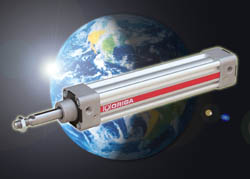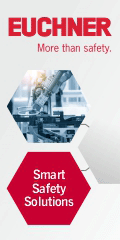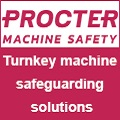
Posted to News on 18th Mar 2007, 19:55
Combining the benefits of hydraulics and pneumatics
Gary Dawson of Hoerbiger-Origa explains how the benefits of hydraulics and pneumatics can be combined within a single linear actuator.

There are many linear actuation applications where the choice between hydraulics and pneumatics is a trade-off. The application calls for the speed of pneumatic operation, but the accuracy or controllability of hydraulics. But there is no longer a need to compromise, because a new breed of hybrid cylinder offers the best of both worlds, by operating with both fluid power technologies.
Over the years, the boundaries between pneumatic and hydraulic cylinder technologies have blurred, and the choice between the two is not clear cut. At the same time, there are also electric drive technologies available now. But even with so many options, there are still applications where the 'perfect solution' does not seem to present itself.
Application examples
Consider, for example, applications where the benefits of speed afforded by pneumatic cylinders are required, but where the compressibility of the air becomes a problem. These are also applications where, for example, smooth motion control is needed but with a varying load, or where the starting and stopping has to be much smoother than can be provided by conventional pneumatic operation.
Consider a machine tool - such as a saw of some kind - where the positioning of the saw is controlled by the linear actuator (a cylinder). The upstroke of the cylinder will be without load, and the machine designer will, in order to maximise productivity, ideally want to be able to position the saw as quickly as possible. Such an operation is best suited to pneumatics. The return motion, in contrast, where the saw is performing its cutting operation, will be a slower motion under load - and that will most likely be a changing load. This aspect of the design is better suited to hydraulics.
A further example might be a positioning system where the cylinder can run at very high speed through the middle of its stroke, but where the stopping position must be controlled to a high degree of accuracy at the two extremes of the stroke. The high-speed aspect calls for pneumatic operation, but the compressibility of the gas makes accurate positioning much more difficult to achieve. Dampers can be added, of course, but that increases costs and still does not necessarily give the degree of stopping accuracy required, or the smoothness. Hydraulic operation, however, gives far more accurate stopping because the hydraulic oil is not compressible, but does not give anywhere near as good speed through the middle of the stroke.
Hybrid cylinders
So how are these conflicting requirements reconciled without compromising the overall design? An innovative solution is the hybrid cylinder that combines the strengths of hydraulic and pneumatic operation in a single product. Such products really do exist, and are typified by Hoerbiger-Origa's AZ series cylinders, which operate off both a compressed air supply and low-pressure hydraulics.
The AZ piston rod cylinder is the epitome of a good OEM product, offering the maximum possible configuration flexibility. Highly flexible, the AZ cylinder is available in profile tube or tie-rod versions, in both single- and double-acting versions, and with the option of a through-piston-rod configuration. Users can specify single- or double-end air connections, and can select the position of these air connections. Further options include non-rotating or guided versions, high-temperature versions (up to 150degC), ATEX versions, and corrosion-resistant versions. For use in the most aggressive environments, users can also specify metal scraper seals to keep any contaminants out of the cylinder.
Most interesting, though, for machine designers working in applications whose requirements are typified by the conditions discussed, is the ability of the AZ to work in hydraulics mode.
This is achieved by means of a pneumatic valve that operates the cylinder by putting air on the appropriate reservoir to force the oil into the cylinder to generate the cylinder movement. The oil on the other side of the cylinder is returned to the other reservoir. Control is achieved via the adjustable restrictors in the oil lines, and when the control valve is the neutral position, the oil is 'locked' in the cylinder by the two valves holding the cylinder in position. The cylinder movement will be smooth even at slow speeds, and consistent even with varying loads.
Want the latest machine building news straight to your inbox? Become a MachineBuilding member for free today >>















